Not being able to make progress in drawing is mostly a matter of obstacles. Every artist has experienced this frustration simply because stagnation is part of the journey.
What’s more troublesome is not knowing why we are stagnant. We can see that something is off in our drawings, but what exactly?
So, let’s break down the 6 reasons that are currently preventing you from making progress in drawing, and how to address them together.
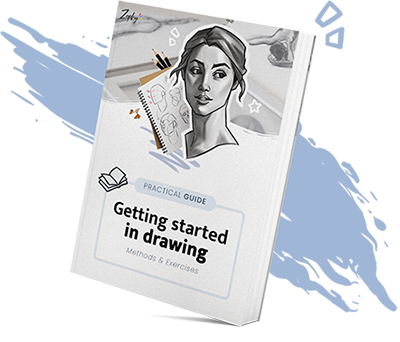
Discover our free guide to start drawing easily. You will learn practical methods and exercises to put into practice right away.
Obstacle 1: You think you need talent
It’s a common mistake to believe that we need a special predisposition to progress in drawing. We think we are simply bad from birth and that others are luckier.
Lack of self-confidence leads us to believe that others have something extra. After all, what’s the point of learning if we are unlikely to measure up to the artists we admire?
And that’s where we’re completely wrong! Believing in the existence of innate talent is the biggest limiting belief in drawing. It absolves us of responsibility, as if we were no longer in control of our own success. It hinders our progress and prevents us from realizing our potential.
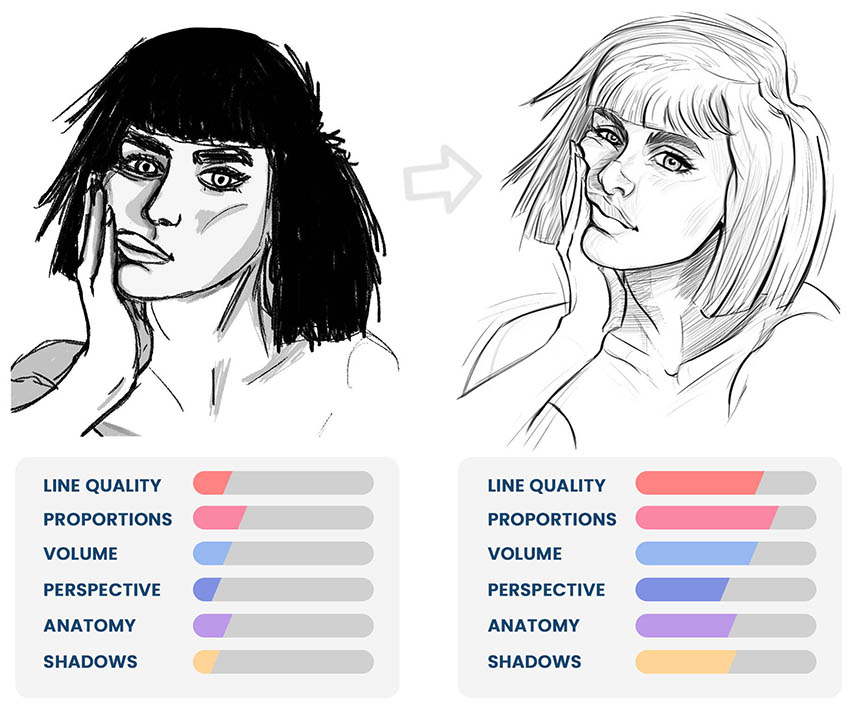
🎨 There are no secrets, I started from scratch myself before mastering the basics of drawing. Every artist must first go through this somewhat embarrassing phase where they can’t draw. It’s completely normal. The important thing is to know how to get out of it and stop stagnating.
💡 The solution: Take back control
If you feel that you lack confidence and have the impression that you don’t have what it takes to be a good artist, I invite you to read the complete article I dedicated to this topic: “Do You Need Talent to Draw?” It is absolutely essential that you read it to break free from this limiting belief.
Obstacle 2: Not Learning to Observe Like an Artist

We tend to draw what we see without truly understanding it. We sketch the outlines of what we want to depict without grasping the forms.
🧠 The brain filters the information
Let’s do a little exercise together to improve our observation skills:
🔹 Carefully look at all the blue objects present in the room where you are. ⚠️ Don’t read further until you’ve completed this exercise, as it will have a greater impact.
🔸 Done observing? Great! Now, close your eyes and try to list as many red objects as you can remember in the room. Yes, you read that right, red objects.
Do your best to list as many as possible, then open your eyes and look around again. You’ll probably realize that you missed quite a few, right?
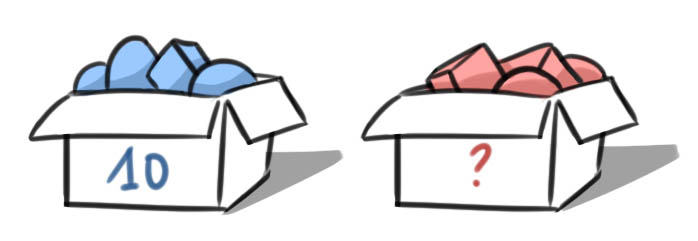
With this exercise, the goal is to understand that when we make a list of blue objects, our brain automatically filters out everything else. It focuses all its memorization efforts on the blue objects only.
Observation in drawing works in the same way. It’s as if we stubbornly see only the blue objects when we should also notice the red ones.
Our brain has never been trained to observe properly in order to draw accurately. We conditioned it to see only what we want to see.
🧠 The brain thinks in symbols
When we encounter difficulties while drawing, our brain tries to help us. For instance, when drawing an eye, it might think: ‘An eye is simple, it has an almond shape.’
And that’s where the problems arise. Our brain attempts to interpret the element we are trying to draw using symbols to simplify what we see. Eyelashes become mere lines, and the pupil a simple circle.
However, relying on these simplifications is not enough to truly progress in drawing. We end up with rough approximations based on our memory.
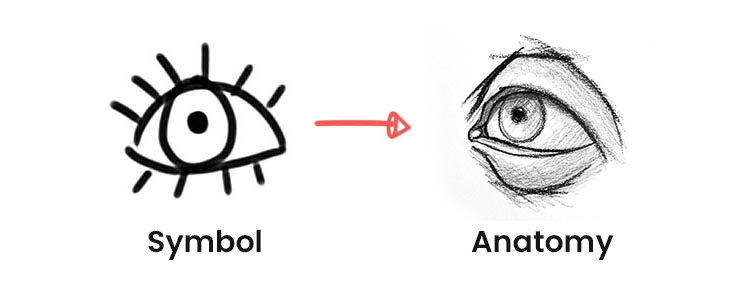
💡 The Solution: Analyzing References
It is essential to understand that drawing works in different layers. The drawing is composed of various categories (proportions, volumes, shadows…).
By taking the time to analyze and dissect our references as we see in the guide to get started in drawing, we will become better at observing like a true artist. The better we observe, the better we draw!
Obstacle 3: You Pay Too Much Attention to Details
We often tend to consider perfectionism as a great quality, but it can become a real problem when we try to learn how to draw. By seeking a perfect result, we become counterproductive.
It is entirely normal to desire to create beautiful drawings that we can be proud of. This gives us a sense of progress and development of our skills, which is rewarding.
However, it sometimes leads us to spend hours perfecting every detail of our drawing with excessive meticulousness.
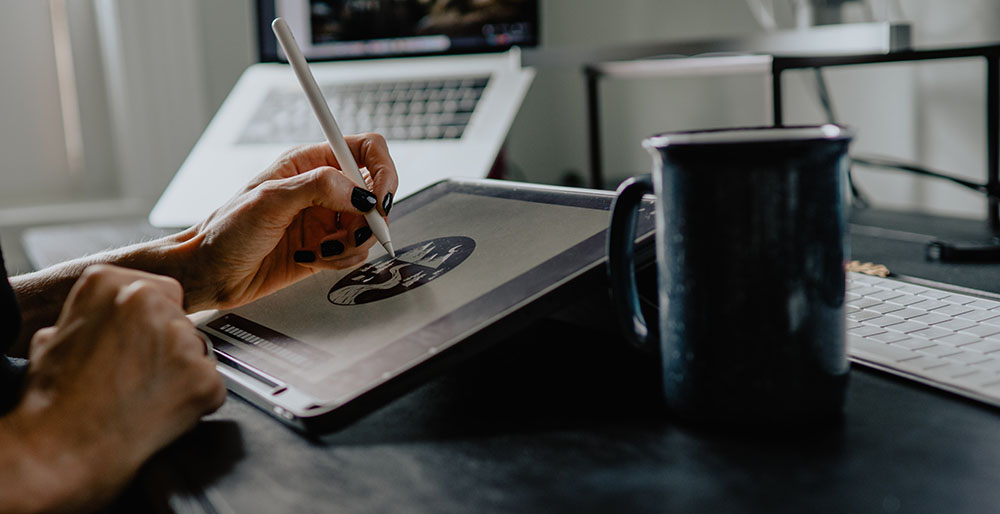
What we don’t always realize is that this excessive perfectionism becomes a huge obstacle to our progress in drawing. By focusing on insignificant details, we miss the essential aspects.
Each drawing we create should be an opportunity to learn and to experiment, and to study. If we concentrate solely on the final result, we don’t gain any insights from our practice!
We end up wasting valuable time without truly learning. Breaking free from this habit of wanting everything to be perfect is a challenge, but it is essential.
I genuinely encourage you to observe this behavior in yourself, and see if you also spend too much time on adding details. If that’s the case, ask yourself this question: ‘Am I truly learning how to draw, or am I simply seeking a beautiful final result?’
💡 The solution : Quick Sketches
Drawing quick sketches allows, in my opinion, to achieve the most significant results in a short period of time.
It’s a method that involves drawing the same element multiple times, improving it each time. The idea is to create variations and explore, while analyzing our mistakes at each step.
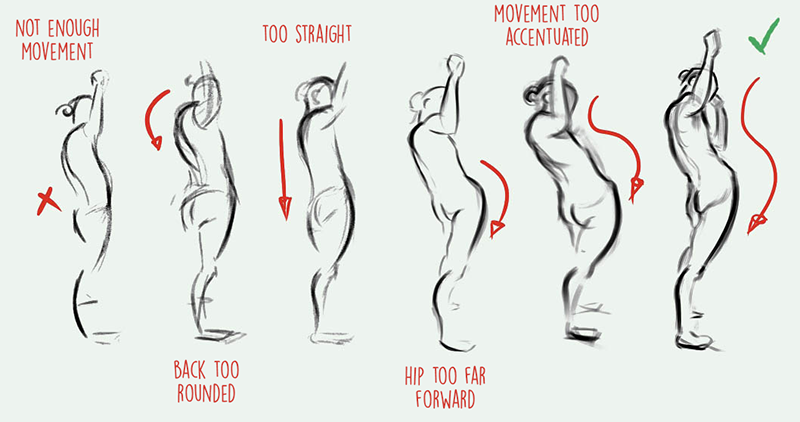
For example, here I had to draw the same character 6 times to get a satisfactory result. If I had stopped at the first drawing, I wouldn’t have been able to analyze my mistakes and wouldn’t have made any progress.
The goal is to create dozens of practice drawings rather than spending hours on a single artwork.
Obstacle 4: You don't have realistic goals
It is common to want to learn how to draw quickly, to be able to easily draw everything we want. After all, if we seek to learn how to draw, it is primarily for enjoyment.

We are tempted to draw only subjects that appeal to us. But in reality, if we are not capable of drawing a cube, how could we draw a dragon, for example?
By adopting this approach, we risk becoming discouraged and giving up quickly. Drawing will seem too difficult if the subject is too complex to draw!
Progressing in drawing may seem out of reach, and this affects our self-confidence and self-esteem.

Adopting a progressive approach in our drawing journey is essential. We can be proud of our creations while recognizing that there is always room for improvement.
Let’s think of it as learning a new language. We cannot expect to become bilingual in two days, as that would be a completely unrealistic goal! However, we can set achievable goals, such as learning one vocabulary word per day.
💡 The solution: Clear and achievable goals

By focusing on achievable goals, we can really boost our progress. Drawing largely depends on our mindset and perseverance.
Let’s imagine a person who wants to start exercising. Let’s call her Alice. It’s her first day at the gym. Which scenario is more plausible?
👉 SCENARIO 1
Alice decides to start training on the first machine she sees, setting the maximum weight. Obviously, she can’t perform the exercise properly, gets discouraged, and injures herself. She feels inadequate, deep down she knew it: she’s not cut out for sports.
👉 SCENARIO 2
Alice begins by scheduling a session with a coach who sets achievable goals for her and establishes a strategy to reach them. She starts with very light weights, gradually increasing the load each week. A few months later, she has tripled the amount of weight she could lift initially.
Clearly, the second scenario is the ideal path for Alice to progress steadily and effectively. It’s better to set modest yet attainable goals and gradually increase the level over time.

Drawing is not a sprint but a marathon. Unfortunately, most people are stuck in the first scenario without even realizing it.
Obstacle 5: You are not consistent enough in your efforts
Beginners in drawing often experience stagnation due to a lack of rigor and self-discipline. Consistency is a crucial quality to make real progress in drawing.
It’s easy to get discouraged by the obstacles we have already listed: fear of lack of talent, difficulties in observation, excessive attention to details, and unrealistic goals. This discouragement often leads to irregularity in our practice.
We draw occasionally, whenever we feel like it. While drawing for pure pleasure is wonderful, to achieve concrete results, we need to go beyond that.
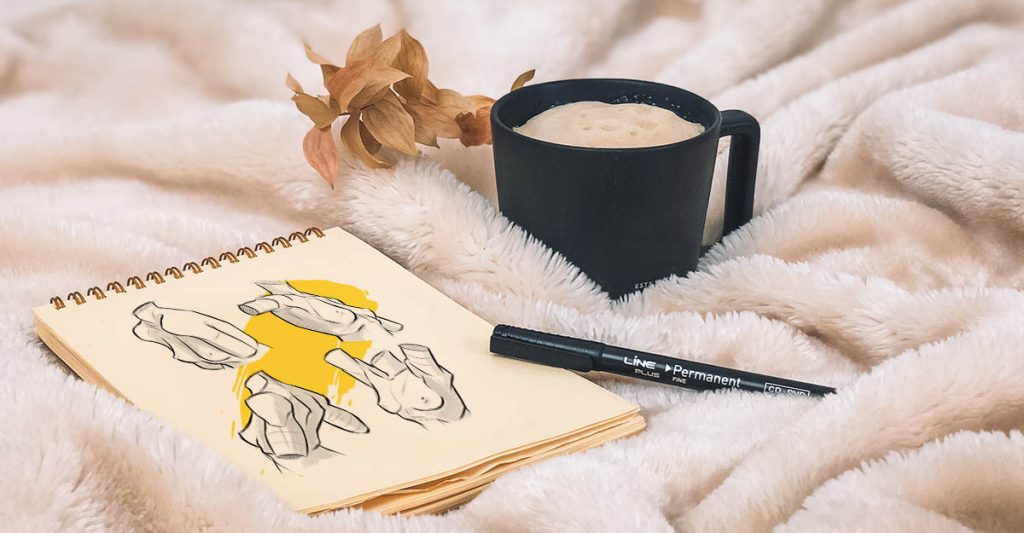
To make progress as an athlete, one must train regularly and establish a consistent routine.
Running for 10 minutes sporadically will not yield significant results. However, running for 10 minutes every day will be much more beneficial.
Before aiming for peak performance by running for 3 hours straight, the athlete will first focus on maintaining their daily commitment, being present day after day. The same principle applies to drawing, where prioritizing consistency over quantity is essential.
💡 The solution : Creating a routine

By committing to just 10 minutes of drawing each day, you will develop your self-discipline and start seeing initial results.
Devoting 10 minutes per day is equivalent to more than an hour per week, which adds up to around 5 hours per month.
The goal is not necessarily to become a dedicated artist spending 10 hours a day drawing. The main idea is to develop discipline by setting aside at least 10 minutes every day to improve.
Once you integrate this small habit into your daily life, your drawing sessions will become a routine, a reflex.
🕓 Of course, ideally, you can gradually increase your practice time based on your energy and schedule.
Obstacle 6: You don't have a Process to Follow
“In general, we dive into drawing with all our heart and soul without knowing exactly what we are doing. With all the resources that the internet offers, it becomes extremely challenging to know where to start.
You grab your pencil, you stare at your paper, and you feel paralyzed. Without a clear path to follow, you embark on each drawing in a chaotic manner. Quite a headache, isn’t it?
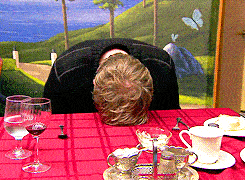
At best, you stagnate, and at worst, you become discouraged. It’s like trying to climb Mount Everest wearing flip-flops. It is absolutely essential to equip yourself and establish a strategy for progression.
💡 The solution: Establish a simple process
The idea is to stick to simple steps that you can make your own. To better help you understand, I will share with you the process that allowed me to approach drawing with ease.
By going through a concrete example together, we will overcome these 6 barriers and trigger your first progress in just 10 minutes.
📌 Practical exercise: The process to follow for better drawing
🔸 Step 1: The example of the beetle
You are now forbidden from looking at any photos of beetles. Take a piece of paper and draw a beetle from the front.
If you have no idea how to do it: even better. As in our example with blue and red objects, you have already seen beetles, but your brain filtered out all the details. It only remembers the general idea of what a beetle looks like.
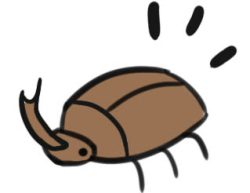
Once your sketch is done, set it aside and don’t touch it anymore. Now, let’s move on to the next step.
🔸 Step 2: The references

Now, let’s find photo references of beetles. Save a few pictures on your computer, preferably from various angles to get a comprehensive view of the insect. And there you have your first reference folder.
🔸 Step 3: Study the shapes
Now that you have saved your beetles photos, let’s take 5 minutes to observe them closely. Draw directly on the pictures to understand each shape one by one and dissect them.
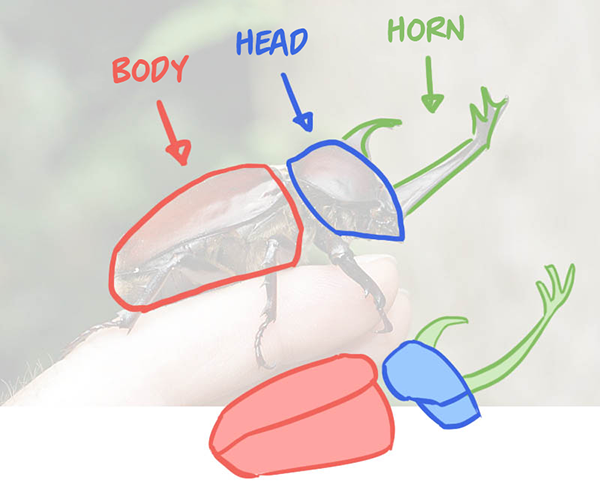
The idea is not to trace, but to observe and learn to simplify what you see. In the end, the beetle is made up of simple shapes.
Take the time to observe the proportions, distances, and main shapes. Do this on an ample number of photos to allow yourself enough time to study your insect.
It might not be the most enjoyable step, but it is the most crucial one! By dedicating time to study the subject you want to draw, you will find it much easier to draw it from imagination later on.
🔸 Step 4: Draw from a photo
Select one of the photos you previously saved and this time, draw next to it. Thanks to the previous step, we already know more about beetles.
Simply draw what you see, trying not to spend more than 10 minutes on it. Don’t worry about the details; focus on the main shapes and proportions based on what you learned just before.
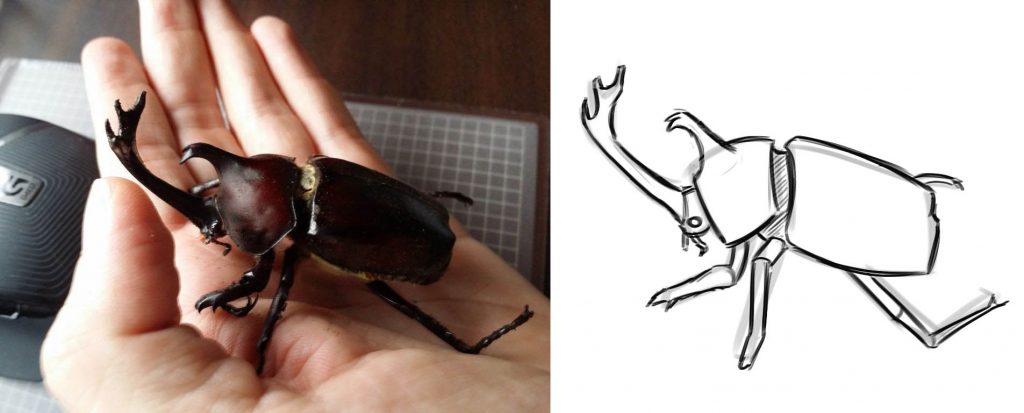
🔸 Step 5: Final sketch
Now, use your references to draw your beetle in a different pose. For instance, try drawing it from a top-down view.
Now that we understand the shapes that make up our scarab, the references serve as our guide. We are no longer copying but interpreting based on what we observed and studied.
The beetle’s body resembles a rectangular shape. We can see that its head is about one-third of its body. Its legs have two joints each. We take the time to observe and analyze!
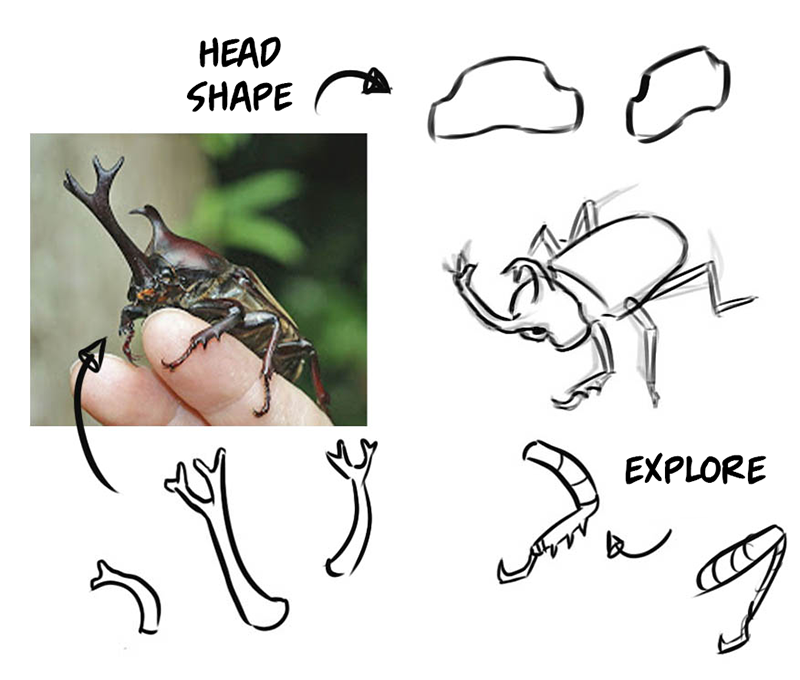
Now, set aside all your references and try once again to draw your scarab from memory. Then, compare your first drawing to your latest one. Congratulations, you have made progress in just 15 minutes!
We can see a significant difference between the initial and the final drawings. The reason is simple: we took the time to study and observe carefully what we wanted to draw.

We can use this creative process for absolutely anything. From now on, we are capable of approaching any drawing with this simplified method.
To summarize
By breaking down these barriers, we will be able to boost our progress
and achieve real results in our drawing skills. Let’s recap the 6
obstacles that hinder our progress:
- Obstacle 1: Thinking we need talent
- Obstacle 2: Not taking the time to observe
- Obstacle 3: Paying too much attention to details
- Obstacle 4: Setting unrealistic goals
- Obstacle 5: Not being consistent enough
- Obstacle 6: Lacking a clear process to follow
There is no secret. Drawing is not just about practice and technique. The mindset plays a significant role in our progress.
By working on our limiting beliefs and adopting the right mindset, we can improve in drawing much faster than we think.
Let’s not forget that drawing is just a skill, and it can be learned, well within our reach. ✍️
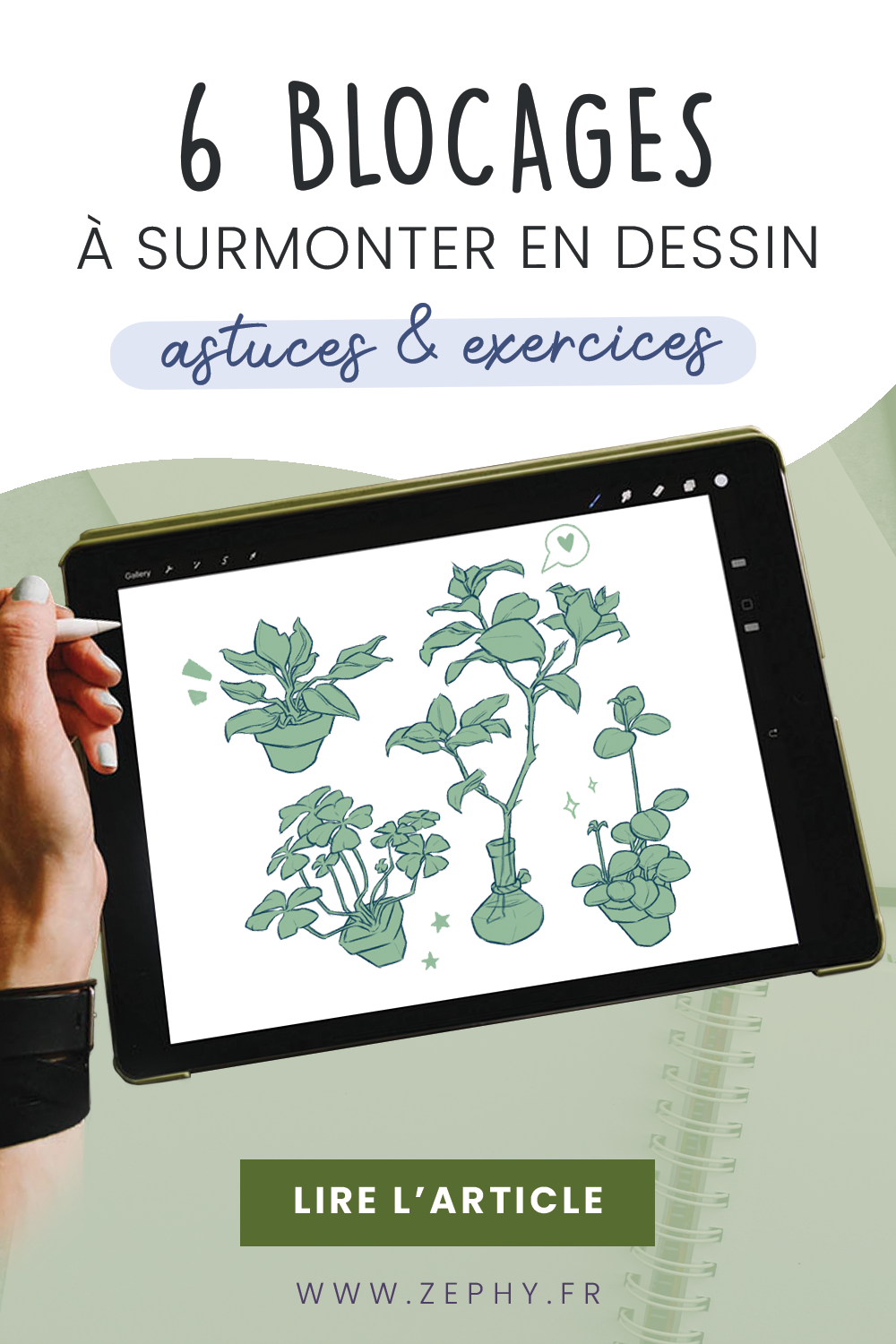

Save the article for future reference!
By hovering over the image, you can directly save the article to your Pinterest account. This also allows us to share the article with a wider audience of aspiring artists!

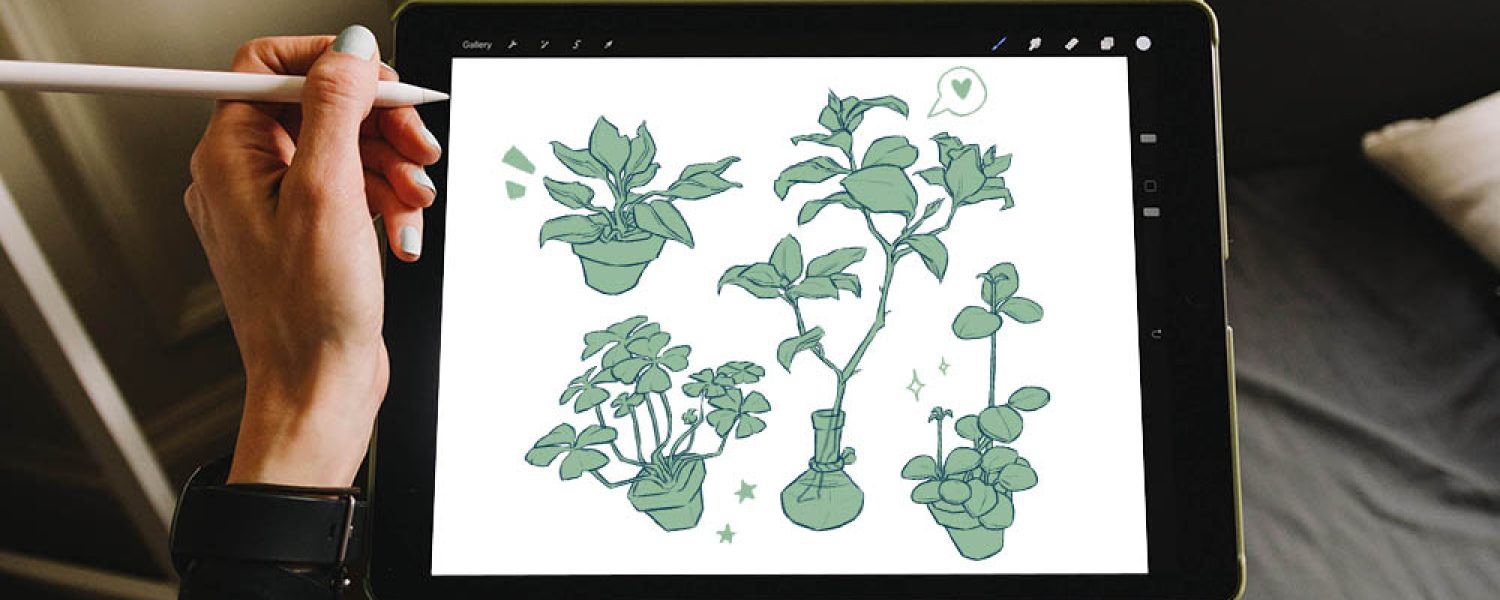

7 comments
Bravo the artist!
Thanks Marie !
Thank you for the article, I just want to add that drawing is like writing, you need to learn the alphabet. In drawing, that means learning to make lines and simple shapes. Drawing is primarily about doing exercises with lines and shapes.
We don’t think in symbols, but in forms. When you watch a child, they make simple shapes, sticks, circles, ovals. For your information, a child doesn’t see the details as it will come with adolescence. I often say that you have to look like a child to learn how to draw.
Thank you so much for this article, it has helped me a lot to understand and learn. I plan to break all the barriers 😊
With great pleasure, very happy that the content can be helpful! ✨
Very nice article. The process to follow for drawing anything is really helpful for me. Thank you, Zephy
The trick, in my opinion, is to draw what we see and not what we know. What’s frustrating is not being able to create a drawing that we can perfectly visualize in our imagination, like a movie playing in our mind.